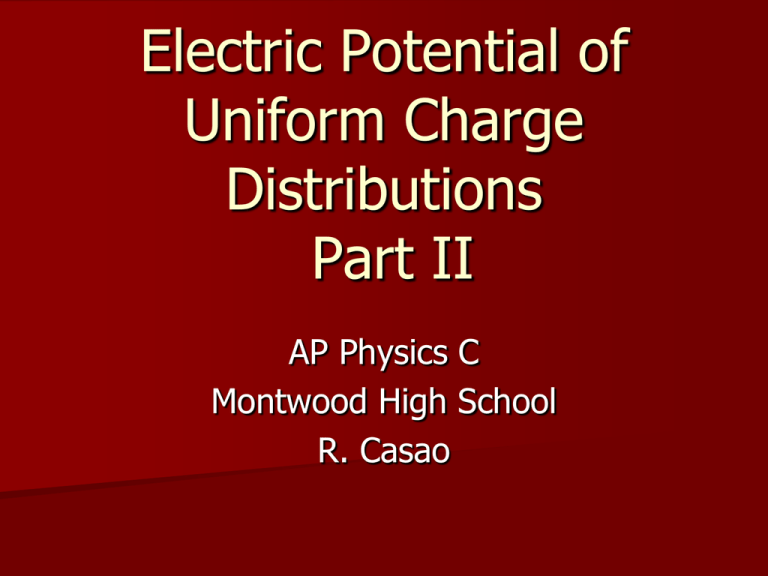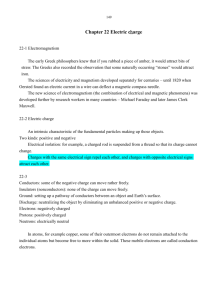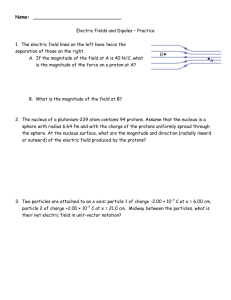Electric Potential of Uniform Charge Distributions 2
advertisement

Electric Potential of Uniform Charge Distributions Part II AP Physics C Montwood High School R. Casao Potential Difference Due to a Circular Arc of Charge Consider a plastic rod having a uniformly distributed charge –Q that is bent into a circular arc of radius r. The x-axis passes through the center of the circular arc and the point P lies at the center of curvature of the circular arc. We will determine the potential difference V due to the charged rod at point P. The equation for arc length is: s = r·. Divide the circular arc into small, equal pieces of length ds. Potential Difference Due to a Circular Arc of Charge Potential Difference Due to a Circular Arc of Charge Each length ds will contain an equal amount of charge dq. Q λ L Q Ls λ s Uniform charge density allows us to set up a proportional relationship between Q, s, dq, and ds: Q dq s ds dq λ ds Potential Difference Due to a Circular Arc of Charge Each length ds containing charge dq contributes to the net electric potential at point P and can be considered as a point charge: k Q V r becomes k dq dV r Keep the sign of the charge in the problem because electric potential is a scalar quantity. There is no direction associated with the electric potential. Potential Difference Due to a Circular Arc of Charge The distance of any element of charge dq to point P is a constant r (the radius). The angle with respect to the x-axis is different for each element of charge dq. s rθ ds r dθ For each element of charge dq: k λ ds dq λ ds dV r k λ r dθ dV dV k λ dθ r Potential Difference Due to a Circular Arc of Charge The net electric potential at point P is the sum of the contribution for each element of charge dq from one end of the circular arc ( = - p/3) to the other end ( = p/3). π π dV k λ dθ 3 π 3 3 π 3 Potential Difference Due to a Circular Arc of Charge On the left side of the equation: the sum of the contributions to the electric potential dV at point P is the electric potential V. π dV V 3 π 3 On the right side of the equation: π π k λ dθ k λ dθ 3 π 3 k λ θ 3 π 3 π 3 π 3 Potential Difference Due to a Circular Arc of Charge π -π V k λ θ k λ 3 3 2π π π V k λ k λ 3 3 3 2πk λ V 3 π 3 π 3 Because the charge on the plastic circular arc is negative, the electric potential V will be negative. If the charge on the circular arc was positive, the electric potential V would be positive. Electric Potential of a Uniformly Charged Disk Electric Potential of a Uniformly Charged Disk Surface charge density: Q σ A Divide the disk into concentric rings which will increase in size from the center of the disk to the outer rim of the disk. r is the distance from the center of the disk to a particular ring. Each ring will have a different charge, radius, and area. Electric Potential of a Uniformly Charged Disk Electric Potential of a Uniformly Charged Disk For each ring, as the radius changes from the center of the disk to the ring location, so does the amount of charge on the ring and the area of the ring. Electric Potential of a Uniformly Charged Disk A πr 2 r radius of ring π 2 r dr dA d π r π d r dA 2 π r dr 2 2 For each ring: Q dq dq σ A dA dA dq σ dA dq σ 2 π r dr dq 2 π σ r dr Electric Potential of a Uniformly Charged Disk dq is expressed in terms of dr because the radius of each ring will vary from the center of the disk to the rim of the disk. The charge within each ring can be divided into equal elements of charge dq, which can then be treated as point charges which contribute to the electric field at point P. R is the distance from dq to point P. Electric Potential of a Uniformly Charged Disk For each element of charge dq: k Q k Q V becomes V r R k dq k 2 π σ r dr dV dV R R R r x 2 2 2 dV R r x 2 R r x 2 2 2 π k σ r dr r 2 x 2 1 2 2 1 2 Electric Potential of a Uniformly Charged Disk To determine the electric potential at point P, add each contribution from every element of charge dq on the disk. Integrate with respect to the radius from the center of the disk (r = 0) to the outer rim of the disk (r = R). dV 0 0 R R 2 π k σ r dr r 2 x 2 1 2 Electric Potential of a Uniformly Charged Disk On the left side of the equation: the sum of the contributions to the electric potential dV at point P is the electric potential V. dV V R 0 On the right side of the equation: the 2, k, s, p, and x are constant and can be pulled out in front of the integral. 2 π k σ 0 r dr R r 2 x 2 1 2 Electric Potential of a Uniformly Charged Disk This integral has to be solved by substitution (there is no formula for this integral on the integration table): – Let u = r2 + x2 – Then du = 2·r dr + 0; du = 2·r dr. – The derivative of x2 is 0 because it is a constant and the derivative of a constant is 0; r is a quantity that changes. du du 2 r dr r dr 2 r dr du 1 du 1 1 2 2 12 r x 2u 2 2 u 2 Electric Potential of a Uniformly Charged Disk 1 2 2 2 1 1 du 1 1 u 2 1 u du 2 2 2 1 2 u 2 2 2 1 2 1 1 u 1 2 u 2 r2 x 2 2 1 2 2 1 2 The electric potential V at point P is: V 2 π k σ r x 2 2 1 R 2 0 Electric Potential of a Uniformly Charged Disk The electric potential is: V 2 π k σ R V 2 π k σ R V 2 π k σ R x 2 2 x 2 2 x 2 2 1 1 1 2 0 x 2 x 2 x 2 2 1 2 2 1 2 Application of Gauss’s Law to Charged Insulators The electric field E: E = 0 N/C at the middle of the charged insulator. E increases from the middle of the charged insulator towards the surface. E reaches its maximum value at the surface of the charged insulator. Application of Gauss’s Law to Charged Insulators To move a positive test charge from the middle of the charged insulator to the outer surface, the work required increases as the test charge moves from the middle of the charged insulator to the outer surface. Application of Gauss’s Law to Charged Insulators The maximum amount of work is performed as the test charge reaches the outer surface. No additional work is required to move the test charge beyond the outer surface. Application of Gauss’s Law to Charged Insulators Inside the sphere: Low voltage occurs in center of the sphere. High voltage occurs at the outer surface of the sphere. Electric field lines inside the uniformly charged sphere are directed radially inward from the outer high voltage surface to the low voltage center. Application of Gauss’s Law to Charged Insulators Electric field lines extend radially outward from the high voltage surface to 0 J/C at . From to the surface, the work needed to move a positive test charge from to the surface increases from 0 J to a maximum value at the surface of the sphere.






